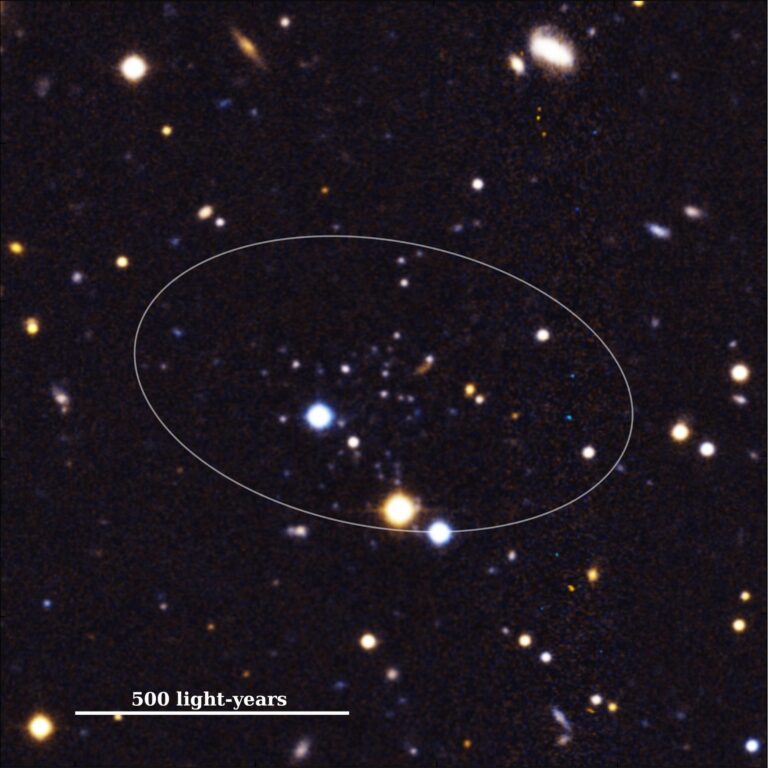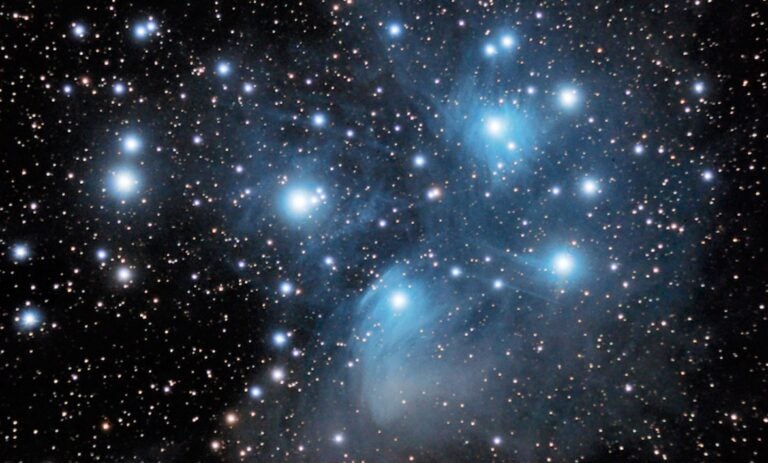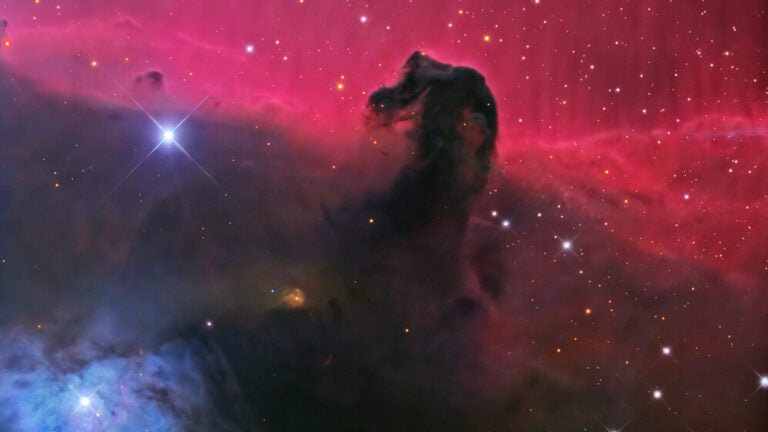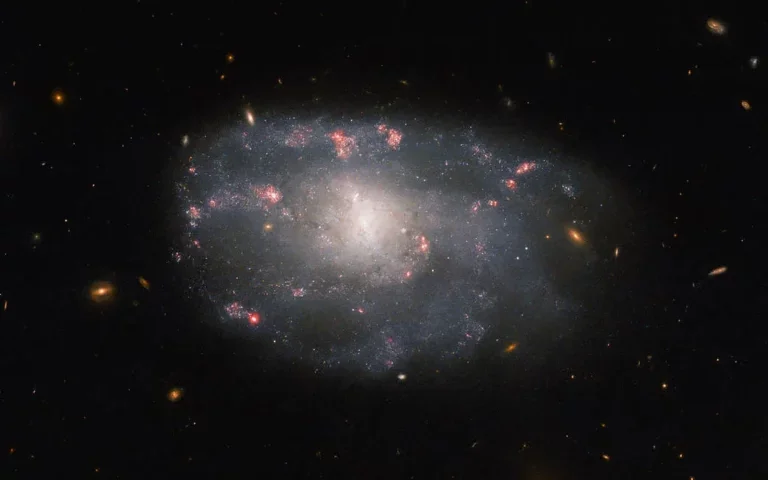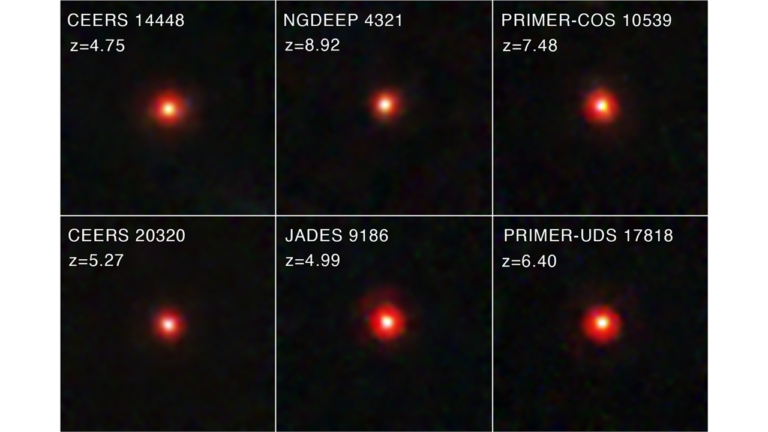What’s a large telescope? The notion of what’s big changes from observer to observer, but generally speaking, any scope of more than 10 inches’ aperture is still considered to be a big one. Although several of the following objects are easily visible in scopes smaller than 12 inches, I’ll be tailoring my remarks about them with large scopes in mind.
Spiral galaxy NGC 210
Let’s start with a strange galaxy tucked in a constellation that doesn’t garner much attention – Cetus the Whale. NGC 210 is an Sb-type spiral lying some 70 million light-years away and yet it glows relatively brightly at magnitude 11 and covers some 5 by 4 arcminutes.
This galaxy appears like a jewel for observers with large sized telescopes because its bright inner core lies embedded in faint, loose arms that you can see as a nebulous haze. Observers with really big backyard scopes might try to spot a faint edge-on background galaxy behind one of NGC 210’s arms.
Planetary nebula Jones 1
If you really want to push the limits of your observing skill, go after a weird planetary nebula in the constellation Pegasus. Also known as PK 104-29.1, Jones 1 is one of the faintest planetaries you’ll ever see. It glows feebly at magnitude 15 and has a large diameter of 5.5 arcminutes, making its surface brightness extremely low. In other words, its light is spread around so much that little individual bits of it appear extremely faint.
This object is sometimes a difficult target even for astroimagers. Armed with a 20-inch or larger scope, a very dark sky, and a high-quality eyepiece, you should be able to see Jones 1 visually. But it will forever be on that “ultimate challenge” list.
Planetary nebula IC 289
Another strange planetary nebula, IC 289, lies over in the bright constellation Cassiopeia. This object is much easier to spot and has a peculiar form, a sort of bent ring surrounding a 16th-magnitude central star. On really dark nights, see if you can detect the star, the bright ring of nebulosity, and a faint halo of older gas blown off the star in an earlier phase of creating the nebula.
Emission nebula NGC 7129
Observers don’t live by planetary nebulae alone, however. Check out the star forming region NGC 7129 in Cepheus for a challenging treat. This is a nebular complex that includes emission nebulosity and two NGC numbers, 7129 and 7133, and offers a good chance to see lots of reflection nebulae, starlight simply reflecting off dust and on toward us.
Several bright stars lie scattered across the field, making spotting the faint reflection nebulae difficult. Scan slowly with a wide-field eyepiece and then increase your magnification to nudge the stars just out of the field’s edge. This will help you see the faint gas without overwhelming it by the light from bright stars.
The Bubble Nebula (NGC 7635)
One of the darlings of the winter Milky Way lies nearby, the Bubble Nebula, NGC 7635. This emission nebula surrounds an intensely hot star that has been stripped of its outer atmosphere, a Wolf-Rayet star. The intense radiation from the star is ionizing the surrounding gas into the bubble we see.
The Bubble is easy to find in that it lies close to the bright open cluster M52. Once you locate it, you’ll see a bright star and the brightest portions of the bubble, along with shards of glowing nebulosity floating nearby. In a really large scope you may see most of the bubble filling an entire arc of 360 degrees, but the faintest part of the nebula is really faint.
Globular cluster M15
Everyone has a favorite seasonal globular star cluster, and M15 is mine in the fall sky. Located in Pegasus near the star Enif, this great cluster lies on the verge of naked eye visibility and spans 12 arcminutes. A large scope shows M15 with a highly condensed, very bright core and splats of stars resolved around its edges and across the cluster’s face.
M15 has a really neat feature that most globulars don’t in that Pease 1, a very faint planetary nebula, lies within it. To spot this planetary is an extreme challenge and even photographing it is very difficult.
Edge-on galaxy NGC 891
One of the great edge-on galaxies in the sky, NGC 891 lies in Andromeda. The galaxy is readily visible in large scopes, as it glows at 10th magnitude and measures 13 arcminutes long. This Sb-type spiral is aligned perfectly edge-on to our line of sight, meaning a moderate power view will show the galaxy’s broad dust band easily.
The Pinwheel Galaxy (M33)
The Pinwheel Galaxy in Triangulum, also known as M33, is the third bright spiral in the Local Group of Galaxies after Andromeda and the Milky Way. This galaxy is huge and bright, but its light is spread such that it has a pretty low surface brightness. Try gazing at M33 on a very dark night with moderate powers and you’ll see features such as NGC 604, a huge star cloud in the galaxy, as well as knots and kinks in the spiral arms, some of which are giant star forming regions.
Stephan’s Quintet
For a more significant challenge, go back to Pegasus for a view of Stephan’s Quintet, one of the sky’s greatest galaxy groups. Centered on the 13th-magnitude Sd-type galaxy NGC 7320, the group of five interacting galaxies includes NGCs 7317, 7318A, 7318B, and 7319. Moderate magnifications reveal the interaction between NGC2s 7318A and B, in the middle, and the strange barred spiral NGC 7319 and elliptical 7317. The group floats majestically in a rich starfield that makes the sight one of the best in the autumn sky.
Spiral galaxy NGC 7331
I’ll finish off my list of fall sky targets with another Pegasus galaxy, the bright and detailed NGC 7331. This highly inclined Sb-type spiral has knotty arms that reveal dust bands throughout, and several smaller, faint galaxies lie scattered in the region as background galaxies. This is one of the best galaxies of the autumn sky, and should demand your careful observing attention.
There you have it, some of my favorite deep-sky objects for large scopes after 30 years of observing. Be sure to let me know about your favorites by emailing me at editor@astronomy.com. For more about Astronomy magazine, see astronomy.com. Until next time, I’m Dave Eicher, and thanks for watching — I’ll see you out under the stars.
- Interactive star chart StarDome
- Observing basics
- Astronomy‘s weekly observing podcast
- Free weekly e-mail newsletter
- Videos





